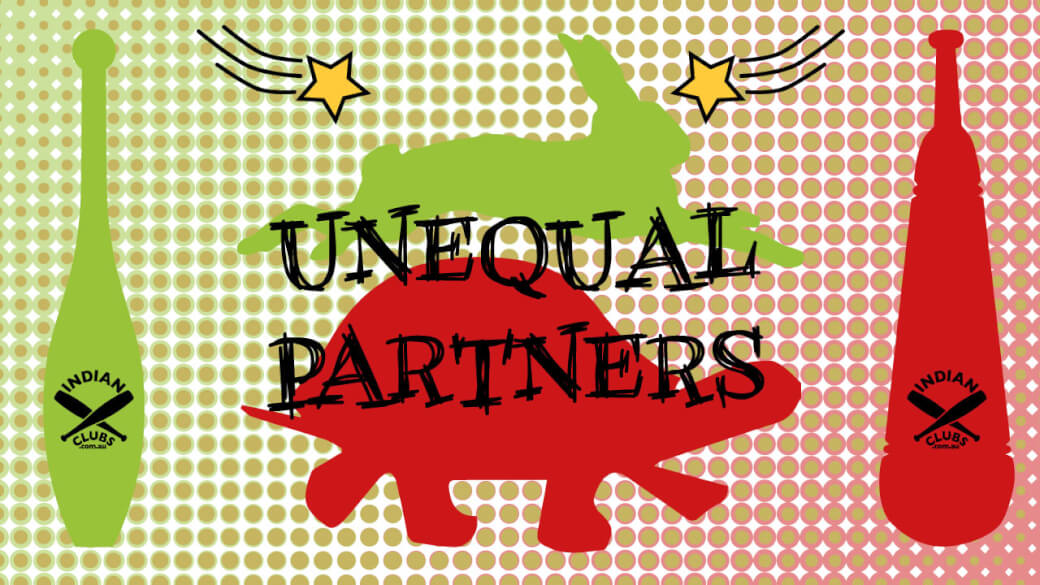The Hare and the Tortoise
Aesop’s Fables, written circa 600BC.
Unequal Partners
The story of the Hare and the Tortoise is about a Hare who ridicules a slow-moving Tortoise. Tired of the Hare’s boastful behaviour, the Tortoise challenges him to a race. The hare soon leaves the tortoise behind and, confident of winning, takes a nap midway through the race. When the Hare awakes however, he finds that his competitor, crawling slowly but steadily, has arrived before him.
The moral of this story is the person who keeps going wins the race.
 |
 |
To make sure that my clubs are unequal partners I chose to use a Meel weighing 3kg and an Indian Club weighing 1.25 kg.
Mentally and physically I like the challenge of coordinating my movements with clubs of different weights.
The Movements
The Meel (The Tortoise) is swung in a standard movement which is an inward back circle, followed by an outward back circle.
The Indian Club (The Hare) is also swung in a standard movement which is a heart shape that consists of two circles, namely a front circle and a back circle. The heart shape is swung both inward and outward, the same as the Meel.
The Challenge
For each circle of the Meel (Tortoise) the Indian Club (Hare) will make two circles. In addition, I want to be able to change the direction of each club without stopping.
The Sequence
The video contains both front and back views.
Starting with INWARD swings, then progress to PARALLEL right, then OUTWARD, PARALLEL left and back to INWARD.
Change hands and repeat the sequence on the other side.
- Inward
- Parallel right
- Outward
- Parallel left
- Inward


very nice, briefly tried it, will work on it!
Hi Thierry, Thanks for the feed back, when you start, try using clubs of the same weight first. Once you are confident with the timings you can look to use a meel.
Your absolutely amazing! Your mind is on fire, and you will never grow stale. The level of thought to coordinate this is truly something.
Thanks Paul.
Mark.
Hi Mark, Thank you for the feedback. Old books say that there is no end to the variations in club swinging, I think that I am starting to believe that now. Hope you are in good health and training is going well.
This variation with different weights is very good for coordination and independence, I try to incorporate my routine!
Hi Julio, Thanks for your comment, it’s definitely a challenge, but I am sure that you can learn how to do it. When you start, use clubs of the same weight. Then when you have the timing under control add a heavier club.
Grazie, è molto interessante e utile il lavoro che sta facendo; sto cercando di imparare ad usare le clave.
Thank you, I am glad to hear that you are learning to use Indian Clubs. I have free lessons at http://www.indianclubsacademy.com which will help you understand the movements.
Absolute genius! Mastery of this will be a long term project.
Thanks for the video and the inspiration ?
Hi Colin, You are right it does take time, but it’s a really fun journey. I think that you will appreciate every step you take, and never get bored.
Using Indian clubs was one of my favorite activities in gym class in high school. It’s been many years since then but, for some reason, I was reminded of it, bought clubs and have started trying to remember how to do it. Your videos are a great help. Have you written any books or could you recommend any?
Hi Gretchen, Thank you for commenting and your feedback. You may find it helpful to visit http://www.indianclubsacademy.com where I have a short free course for beginners, it will also act as a refresher for you. I am in the process of recording a new online course which I hope to complete by late October. In the meantime, you can visit my books page https://www.indianclubs.com.au/indianclubs/indian-club-books/ where you can download a number of manuals for your reference.